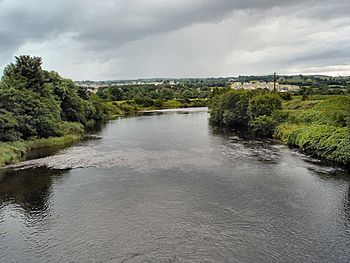River Finn (Foyle tributary) facts for kids
Quick facts for kids River Finn |
|
|---|---|

River Finn
|
|
| Native name | An Fhinn |
| Jurisdictions | Republic of Ireland & Northern Ireland |
| Counties | Donegal, Tyrone |
| Physical characteristics | |
| Main source | Lough Finn, County Donegal |
| River mouth | North Channel via Lough Foyle |
| Length | 63.17 km (39.25 mi) |
| Basin features | |
| River system | Foyle |
| Basin size | 505 km2 (195 sq mi) |
The River Finn (Irish: Abhainn na Finne) is a river that flows through two different countries! It starts in County Donegal in the Republic of Ireland and then goes into County Tyrone in Northern Ireland.
This river begins its journey in Lough Finn, a lake in County Donegal. It then flows east through a deep mountain valley. The river passes by the towns of Ballybofey and Stranorlar, which are on opposite sides of the river. The River Finn then joins with the River Mourne at Lifford.
A smaller stream called the Monellan Burn flows into the River Finn near a tiny village called The Cross. This is not far from where Monellan Castle used to be, just outside Killygordon. From Castlefin downstream, the river gets deeper and is affected by the tides, especially closer to Strabane.
The Finn River is about 40 miles (64 km) long. Together with its helper river, the Reelin River, it drains an area of 195 square miles. The famous River Foyle is actually formed when the River Mourne and the River Finn meet, west of Lifford Bridge. The whole area where the River Finn flows is known as the Finn Valley. You can also find the village of Clady in County Tyrone right on the River Finn. Even the local football team in Ballybofey, Finn Harps, is named after this important river!
Fishing in the River Finn
The upper parts of the Reelin River and the Finn River flow very fast down to Ballybofey. These fast-flowing areas are great for fishing! Further downstream from Ballybofey, the river becomes deeper and moves more slowly.
There are more than 25 miles (40 km) of river where you can fish for salmon. This includes areas from Flushtown all the way up to Bellanmore Bridge, and even part of the Reelan River. You can also find good spots to catch sea trout at Liscooley and Killygordan, and from Ballybofey to Bellanamore Bridge.
The Finn and its helper river, the Reelan, are probably the best rivers in Donegal for catching salmon and grilse (young salmon). Other types of fish found in the Finn River system include roach, perch, eels, and brown trout.
Protecting the River Finn's Wildlife
A very special area called the River Foyle and tributaries Area of Special Scientific Interest (ASSI) helps protect the River Finn. An ASSI is a place that is officially recognized as important for its plants, animals, or geology. This special area includes the part of the River Finn that is in Northern Ireland. It also covers the River Foyle and its other helper rivers like the River Mourne, the River Strule, the River Derg, and two smaller streams called the Mourne Beg River and the Glendergan River.
This protected area covers about 120 km of water. It's special because the riverbanks and channels look very natural, especially in the upper parts of the rivers. It also has a rich variety of plants and animals.
One of the most important things about this area is its huge population of Atlantic salmon. It's one of the largest groups of Atlantic salmon in all of Europe! Scientists have found that the salmon in different parts of this river system are unique and have their own special genetic makeup. This means they are like different families of salmon living in different parts of the same river system.

